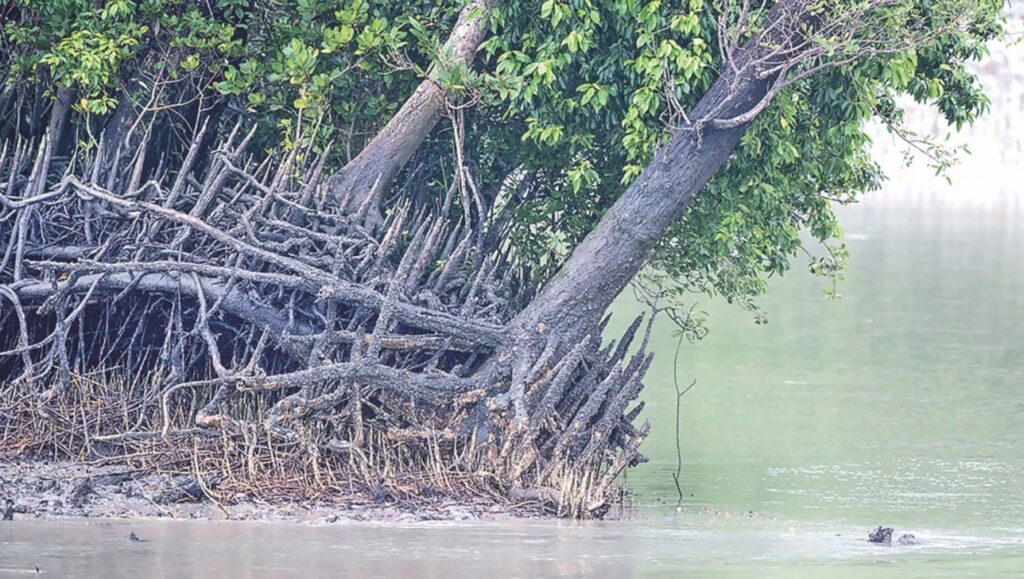Well, the Sundar-bans has done it again! As it has been doing for hundreds of years. This time, it took the blow of super-cyclone Amphan and saved us from severe devastation.
When it comes to saving people from coastal flooding, Bangladesh is one of the top three countries in the world getting the most benefit from its mangroves. A recent study estimated that a 20-km mangrove stretch, especially near cities, could give more than USD 250 million flood protection benefit a year. From these numbers, we can only partly imagine the importance of the Sundarbans to Bangladesh.
Of course, protection against natural calamities is only one of the numerous benefits we get from this magnificent jungle: we have oxygen to breathe in, honey to relish, fish to savour, fuelwood to burn, materials to thatch, waterways to navigate, festivals to celebrate, Bengal Tiger to cherish, beauty to photograph—to name just a few. The Sundarbans may have officially become the world’s heritage when the UNESCO declared it in 1997, but it has always been a heritage to the people of this delta.
Speaking of the UNESCO move, since 2014, the World Heritage Centre (WHC) of this UN body has been expecting some specific actions from Bangladesh with regard to the Sundarbans. Bangladesh’s relationship with the WHC took a sharp turn in 2016 when a WHC-IUCN mission made 10 recommendations after visiting the Sundarbans, including relocation of a coal-based power plant in Rampal near the forest. Over the next three years, we saw numerous media reports on the decisions made in the WHC’s global meetings and Bangladesh’s responses to them.
In the middle of last year, Bangladesh-WHC relations entered a new dimension when IUCN recommended the WHC to put the Sundarbans on the List of World Heritage in Danger, due to insufficient compliance of the WHC’s decisions, creating an uncomfortable situation for Bangladesh in the conservation world.
We have not read much about WHC-Sundarbans since last July. Nevertheless, in January 2020, Bangladesh submitted a comprehensive report to the WHC, which is basically a response to all the 11 decisions taken on Bangladesh’s side of the Sundarbans in the Baku meeting last year. In January, Bangladesh also started preparing a Strategic Environmental Assessment (SEA) of the south-west region of the country, including the Sundarbans—another long-standing expectation of the UNESCO-WHC. Both these crucial developments have, however, gone largely unnoticed by the media.
The 44th meeting of the WHC was supposed to be held at the end of this month in Fuzhou, China, which has now been postponed due to the Covid-19 pandemic. We have to wait to see how UNESCO-WHC and its technical partner IUCN respond to Bangladesh’s recent submission.
But the Sundarbans is not only a world heritage site or an ecosystem torn in the economic development vs nature conservation debates. It is also a restless, silent “trouble-shooter” addressing our societal challenges. Before the Covid-19 swamped the world, we were overwhelmed by two of the biggest crises of our time—climate change and biodiversity loss. While the global efforts to halt these catastrophes are getting delayed due to the pandemic, we cannot suspend our national and local endeavours. And, mangroves are amazing natural systems that can help us tackle both climate and biodiversity crises.
When we involve people and protect our natural mangroves like the Sundarbans, restore the degraded ones like that in Nuniachhara, Cox’s Bazar, or stretch the “green belt” along the coast through coastal afforestation—as we have been doing since 1965—we not only adapt to climate change or take the extra carbon dioxide out of the atmosphere to keep the world cooler or create a refuge for biodiversity, we also ensure food security, disaster risk reduction, human development, and economic empowerment of the people dependent on mangroves, thus contributing to our collective wellbeing.
Like Bangladesh, all countries of the world with mangroves are enjoying tremendous benefits out of them. Globally, mangroves give us USD 65 billion worth of coastal flood protection every year. They annually give us USD 50 billion non-market benefits from fisheries, forestry, and recreation. Putting an amount on the benefits we get from mangroves may justify investing in their protection, restoration, and expansion—after all, the return from preserving and restoring mangrove is 10 times the investment. But how would we value thousands of years of evolution of mangroves? What price can we put on a mangrove when it is the home of hundreds and thousands of butterflies? How much is it worth when we call mangroves our heritage?
Since the onset of the coronavirus crisis, we have seen our priorities shift with the changing situations and demands. In March, as we imposed lockdown restrictions, stopping infection spread was our top priority, putting it even before our economy. A few weeks on, we had to reprioritise people’s livelihoods and national economy over the pandemic. As cyclone Amphan approached our coast in late May, saving human lives became an immediate priority over the risk of disease spread.
As we continue facing climate crisis and biodiversity loss in catastrophic proportions, can protecting the Sundarbans and the nature as a whole be our priority now?
Dr Haseeb Md Irfanullah is an independent consultant working on environment, climate change, and research systems. His Twitter handle is @hmirfanullah

